Designed specifically for business professionals, LinkedIn is a powerful lead generation tool. An enormous network of potential contacts, across every kind of industry, is just a click away. Here's how to use it to generate leads for your business.
According to the 2015 Social Media Marketing Industry Report by Social Media Examiner, Facebook happens to be the most important social network used by marketers. LinkedIn grabbed the number two spot, with 71% of marketers claiming to use it.
Surprisingly, only 21% stated it to be the most crucial social network. Twitter was ranked third with 12% users. However, here’s the kicker based on the same report:
It was found that 66% of the marketers surveyed wanted to sharpen their knowledge on using Facebook while 62% wanted know more on LinkedIn. Furthermore, 66% of marketers showed signs of improving their LinkedIn profile in the next 12 months.
Author of the report and CEO of Social Media Examiner, Michael Stelzner, stated that if your target audience includes other businesses, the research clearly proved that marketers are now doubling down on LinkedIn within a year or so.
What’s so crazy about LinkedIn?
LinkedIn, which was previously known as the dark horse of social media, has now witnessed an ever increasing user base. If Facebook is a platform to talk with your close buddies, LinkedIn is the place where you meet up to get work done.
Want to know the best part?
With access to more than 400 million members spread across different countries, LinkedIn allows sales lead generation success by permitting sales professionals to find the right prospects easily and quickly, thus saving a huge chunk of your time and effort. It’s also a powerful platform which drives the maximum number of customers to B2B companies. So it makes sense to use the platform to generate leads and sell your products to other businesses.
We will now reveal the best strategies packed with effective tactics for LinkedIn lead generation.
1. Optimize your profile to reach out to others
The first step to build a solid lead generation strategy is to grow your network by connecting with other users. A connection paves the way for communication with others. From that point onwards try to apply any tactic what suits you best. We are going to present a few here.
Here’s the first strategy:
Always remember that most of the times you’ll be reaching out to people whom you don’t know. So you need to ensure that your profile is heavily optimized, or else you’ll be seen as a spammer. To understand this, you have to look at what users on LinkedIn see when you send them an invitation.
They will see a mini preview with the title, name and the start of any message you sent in their notifications bar as shown below:
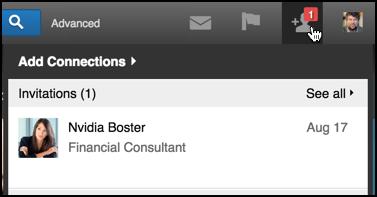
Since they are unknown to you, your invitation may be rejected.
Or they may click on the invitation to view the entire message you sent.
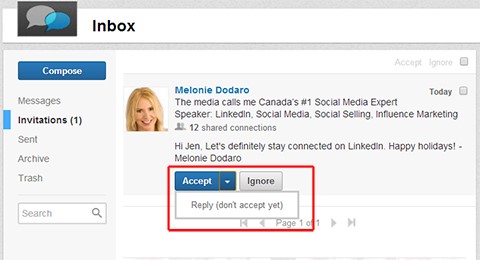
Some of the elements you should focus on whiling composing a message are:
- Picture and name
- Title/Tagline
- Your message
We’ll discuss 3 ways on how you can make your impression stand out.
Your picture and name
Since you cannot do anything with your name let’s keep it as it is. However, when it comes to your image, there’s a bit of leeway. In simpler terms, your profile picture has to be appealing and professional. LinkedIn users will not even put in any efforts to view your profile if you don’t have an appropriate image.
The best thing is to get a professional headshot.
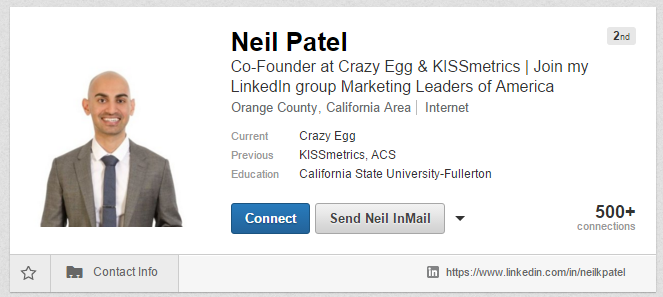
If you can’t do that, put on a professional outfit, stand in front of a white wall, and ask someone to take a picture using your Smartphone. Even though it may be inferior to a professional image in terms of quality, it’ll be good enough to work for you.
Your title
What’s so big about your title?
Your title is referred to as a professional headline by LinkedIn. It’s a decent idea to put your job title along with any other enticing titles you hold. But before jotting down the title, find some time reflecting on the type of people you’ll be connecting to.
Some of the professional titles you can use are:
- CEO
- CMO
- President
- Founder
Remember that your title has to describe what exactly you do.
Here’s a great example of a professional headline which is difficult to miss out:
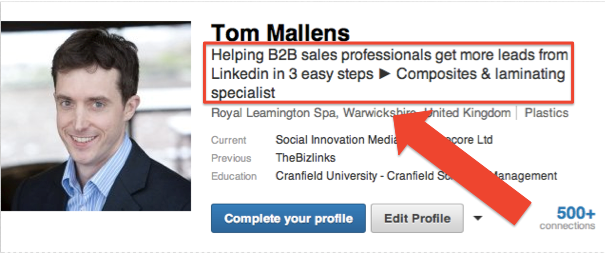
Display specialized certifications
The Certification section on LinkedIn permits you to display your specialized educational achievements which you may feel to be worthy of generating leads. If you hold a certification in your industry, you can mention it here and link it so that users can know more about you.
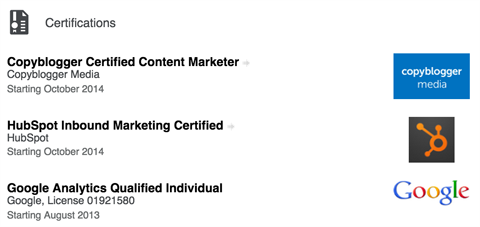
Assuming you nail these three vital elements of the initiation, the user you invited will possibly head to your profile page. Note that they are always trying to ascertain whether you’re legitimate or not.
Some other ways to optimize your profile include the following:
- Focus on your professional skills
- Promote your projects
- Provide links to your publications
- Share your awards and honors
- Display courses relevant to the industry
- Mention your professional memberships
- Demonstrate proficiency of languages you know
- Highlight your LinkedIn groups
Finally, it would do go good if you could use a line showing your interest in connecting with new people.
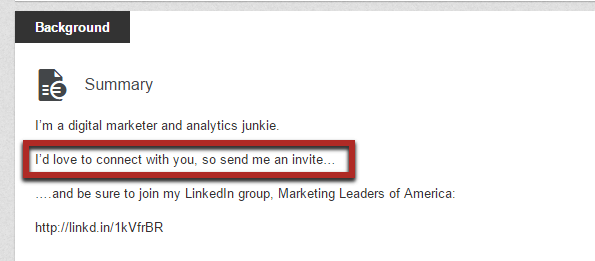
2. Create your list of prospects
We’re now moving to the interesting stuff.
You’ll now be finding people who will turn out to become important leads. The objective is to compile a list of 1000 potential customers to begin with. This may sound like a lot to you, but note that LinkedIn has a huge user base and you should spread your net as far and wide as possible to hook some of them.
To get started, you need to use the built-in search function. Head to the “advanced” tab on the right side of the search bar and click on it. This enables you to get heavily specific with your hunt.
You can narrow down the search results in whatever way you want. However, we’d recommend starting with the Title, Location and Industry.
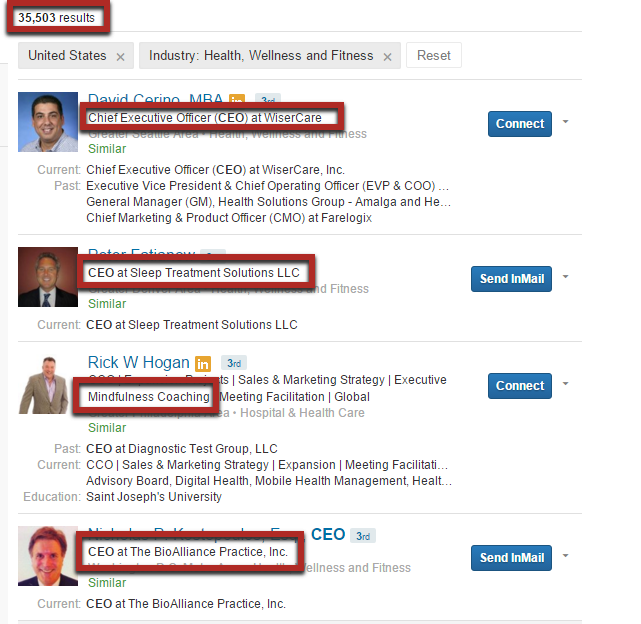
As it’s pretty evident, you’ll be floored by the number of prospects using this technique. Create a spreadsheet and list down their names. You can also copy the URL of their profiles.
Once this is done, it’s time to move into step 3.
3. Get in touch with each member from the list
Since you have done the necessary groundwork, it’s time to plunge into action right now. Now how do you accomplish that?
The aim here is to connect with each and every member appearing on your spreadsheet.
Make your first impression stand out
Here is how an effective connection invitation appears like.
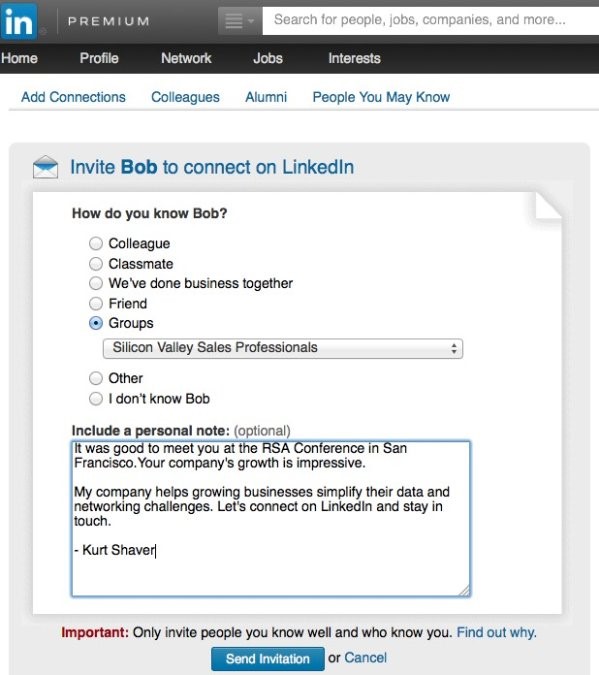
You have the picture and the professional headline, but you can work on it a little more for improved LinkedIn lead generation.
Let the user know what you do and how you can help them grow their business. Your message should focus on what you can give rather than what you can take.
Writing an illustrative opening message
The main part of that initial impression which you want is your opening message.
Remember that you are a complete stranger in the eyes of the user. So you should not expect them to go out on a limb just for you. If you hope for that, they may not likely connect with you or even respond.
An example of a connection message that is bound to fail is shown below:
“I’m your loyal follower on Facebook and absolutely impressed with what you do in life. This is why I would like to connect and learn from you.”
Such an opening message will act as a deterrent for the user in accepting your invitation.
Here’s a pretty impressive opening message:
“I loved your recent post on “25 Mistakes to Avoid While Starting a Blog”. I shared it in my social circles along with members in some of my LinkedIn groups. Would you look forward to connect with me here? We would both benefit from each other. Thank you (Name).”
When you combine this with the other factors mentioned above, your LinkedIn lead generation rate is sure to explode.
While writing a LinkedIn invitation message, be wary of these facts:
- Be honest
- Tell them how you know them
- Find something in common
- Make it personal
- Be enthusiastic
- Read their profile and refer to something in it.
Whenever you send an invite to a stranger, you’ll have many options to choose from. Most of these options entail you to enter the email address of the user, so just pick the option “friend”.
It’s best to send your invitations slowly in the beginning and see how users are reacting to them. Aim for an approval rate of 40% or even higher. Keep tweaking your profile, message and lead targeting until your acceptance rate goes above 50%.
4. Reverse engineering approach
Another terrific way for successful LinkedIn lead generation is by sharing powerful content on relevant LinkedIn Groups that demonstrates your insight and expertise on a particular service or product.
Here’s the one wrong thing many people tend to do on LinkedIn Groups:
Many people make the mistake of joining groups by adopting the spray-and-pray approach. You’ll notice that their contributions and interactions are related only to make sales. A more robust approach is perhaps reverse engineering.
Let’s say, for instance, you sell video marketing services to small-sized businesses and you’ve joined LinkedIn Groups where your prospects hang out. Instead of hard-pressing on your services, compose and share a post on a topic that can be of tremendous interest to your potential customers. This also gives you a scope to highlight your expertise.
In this particular example, you can craft a post which elucidates on how video marketing assists businesses to gain trust within the industry. Create a compelling title, include case studies that back your points and end with a powerful CTA that encourages others to share your post. This will get the ball rolling for a pretty long time.
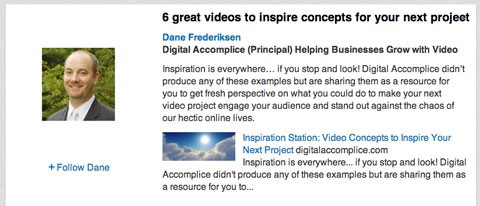
5. Create a group and get it running
Creating a group is pretty simple and takes very little time but it can be tremendously effective for LinkedIn lead generation purposes.
Here’s what you need to know:
The first step is to decide what type of group you want to create and how would your potential customers benefit from it. Think in terms of what your group can offer and not the other way round.
So, if you sell products to manufacturing firms, build a group for manufacturing leaders. If you sell products to online marketers, create one purely for marketers.
Make it sound inviting so that your prospects would join at the drop of a hat. Once you create a group, the first thing is to post a few pieced of content, say 3 to 5 articles.
An effective way to do this is to enter you niche in Buzzsumo. This will reveal a list of the most popular articles in your industry.
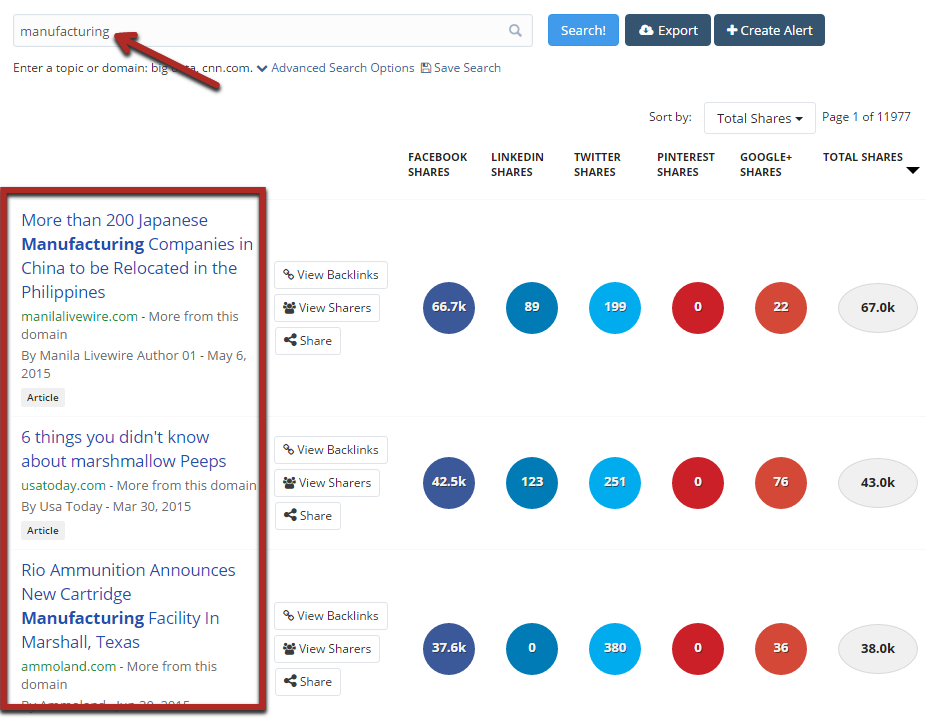
The next step is to create a post for each of them. Write a short intro to each of the articles. An example in this case would be “Why are Japanese manufacturing companies in China relocating to Philippines?”
Once you have a relevant number of posts on your Groups, shoot a message to a new connection, asking him to join the group and how he can benefit by doing so.
After you group has considerable number of members, you need to be active. Use tools like Google News or Buzzsumo to monitor the news every day for any major industry announcements or events.
Encourage other members to freely post their content. Comment, like or share whatever they post. This will make them feel important and venerated members of the group.
Remember that it’s easy to attract new members to your group if it’s active. Here is how Lewis Howes got around 20 new invites each day from his group members.
The main purpose of creating a group is to make the process of connecting with prospects a cakewalk. It also allows you to help establish an authority within the industry, very similar to branding.
The main aim now is to turn all your new connections into leads. These indicate people who are ready to do a sales call, participate in an important event that could result in a sale, or attend a webinar.
Now it’s time you put these techniques into practice.
We have shown just 5 strategies on how to generate solid leads using LinkedIn. Here are 8 more effective ways on LinkedIn lead generation. Keep repeating each process so that you have a stable flow of leads. You will see it making a massive difference when it comes to the growth of your business.


